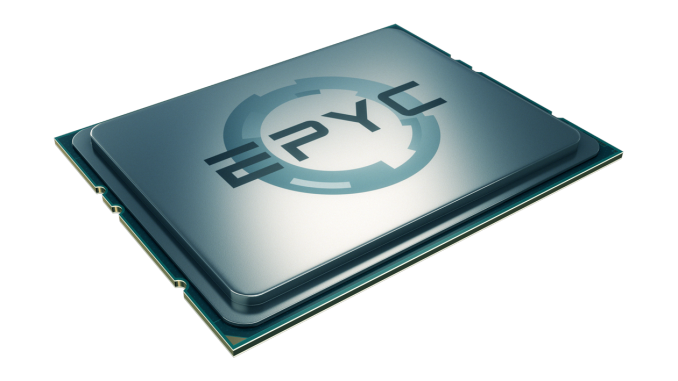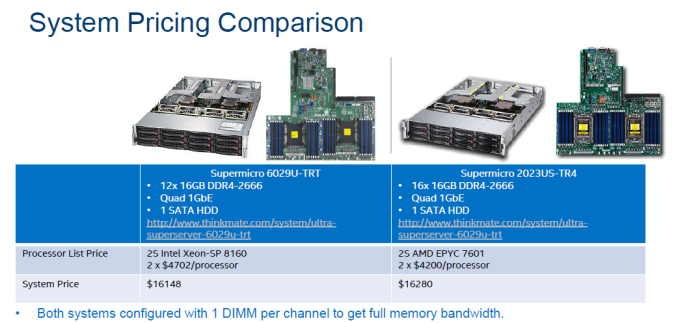Dissecting Intel's EPYC Benchmarks: Performance Through the Lens of Competitive Analysis
by Johan De Gelas & Ian Cutress on November 28, 2017 9:00 AM EST- Posted in
- CPUs
- AMD
- Intel
- Xeon
- Skylake-SP
- Xeon Platinum
- EPYC
- EPYC 7601

Although the AMD EPYC is definitely a worthy contender in the server space, AMD's technical marketing of the new CPU has been surprisingly absent, as the company not published any real server benchmarks. The only benchmarks published were SPEC CPU and Stream, with AMD preferring for its partners and third parties to promote performance. And, as our long-time readers know, while the SPEC CPU benchmarks have their merits and many people value them, they are a very poor proxy of most server workloads.
In every launch, we expect companies to offer an element of competitive analysis, often to show how their platform is good or better than the rest. At the launch of Intel's latest Xeon-SP platform, analysis to EPYC was limited to a high-level, as the systems were not as freely available as expected. AMD was able to do so on Broadwell-E at the time of the EPYC announcement because it was out and available - Intel wasn't able to do it on EPYC because AMD were several months away from moving it from a cloud-only ramp up program. This is partly the effect of AMD's server market implementation and announcement roadmap, although it didn't stop Intel from hypothesising about the performance deficits in ways that caught the attention of a number of online media.
Throughout all of this, AMD could not resist but to continue to tell the world that the "EPYC SoC Sets World Records on SPEC CPU Benchmarks". In the highly profitable field that is server hardware, this could not be left unanswered by Intel, who responded that the Intel Xeon Scalable has great "momentum" with no less than 110 performance records to date.
Jumping to the present time, in order to to prove Xeon-SP dominance over the competition, Intel's data center engineering group has been able to obtain a few EPYC systems and has started benchmarking. This benchmarking, along with justifications of third-party verification, was distributed to the small set of Xeon-SP launch reviewers as a guide, to follow up on that high-level discussion some time ago. The Intel benchmarking document we received had a good amount of detail however, and the conference call we had relating to it was filled with some good technical tidbits.
Our own benchmarks showed that the EPYC was a very attractive alternative in some workloads (Java applications), while the superior mesh architecture makes Intel's Xeon the best choice in other (Databases for example).
A Side Note About SPEC
A number of these records were achieved through SPEC. As mentioned above, while SPEC is a handy tool for comparing the absolute best tweaked peak performance of the hardware underneath, or if the system wants to be analysed close to the metal because of how well known the code base is, but this has trouble transferring exactly to the real world. A lot of time the software within a system will only vaguely know what system it is being run on, especially if that system is virtualised. Sending AVX-512 commands down the pipe is one thing, but SPEC compilation can be tweaked to make sure that cache locality is maintained whereas in the real-world, that might not be possible. SPEC says a lot about the system, but ultimately most buyers of these high-end systems are probing real-world workloads on development kits to see what their performance (and subsequent scale-out performance) might be.
For the purposes of this discussion, we have glossed over Intel's reported (and verified over at SPEC.org) results.
Pricing Up A System For Comparison
Professionals and the enterprise market will mention, and quite rightly, that Intel has been charging some heavy premiums with the latest generation, with some analysts mentioning a multiple jump up in pricing even for large customers, making it clear that the Xeon enterprise CPU line is their bread and butter. Although Intel's top-end Xeon Platinum 8180 should give the latest EPYC CPU a fit of trouble thanks to its 28 Skylake-SP cores running at 2.5 to 3.8 GHz, the massive price tag ($10009 for the standard version, $13011 for the high-memory model) made sure that Intel's benchmarking team had no other choice than also throwing in a much more modest Xeon Platinum 8160 (24 cores at 2.1 - 3.7 GHz, $4702k) as well as the Xeon Gold 6148 (20 cores at 2.4-3.7 GHz, $3072).
| SKUS Tested | |||||
| Intel Xeon Platinum 8180 |
Intel Xeon Platinum 8160 |
Intel Xeon Gold 6148 |
AMD EPYC 7601 |
||
| Release Date | Early Q3, 2017 | Late Q2, 2017* | |||
| Microarchitecture | Skylake-SP with AVX-512 | Zen | |||
| Process Node | Intel 14nm (14+) | GloFo 14nm | |||
| Cores / Threads | 28 / 56 | 24 / 48 | 20 / 40 | 32 / 64 | |
| Base Frequency | 2.5 GHz | 2.1 GHz | 2.4 GHz | 2.2 GHz | |
| Turbo | 3.8 GHz | 3.7 GHz | 3.7 GHz | 3.2 GHz | |
| L2 Cache | 28 MB | 24 MB | 20 MB | 16 MB | |
| L3 Cache | 38.5 MB | 33.0 MB | 27.5 MB | 64 MB | |
| TDP | 205 W | 150 W | 150 W | 180 W | |
| PCIe Lanes | 48 (Technically 64 w/ Omni-Path Versions) | 128 | |||
| DRAM | 6-channel DDR4 | 8ch DDR4 | |||
| Max Memory | 768 GB | 2048 GB | |||
| Price | $10009 | $4702 | $3072 | $4200 | |
As a result of this pricing, one of the major humps for Intel in any comparison will be performance per dollar. In order to demonstrate that systems can be equivalent, Intel offered up this comparison from a single retailer. Ideally Intel should have offered multiple configurations options for this comparison, given that a single retailer can intend for different margins on different sets of products (or have different levels of partnership/ecosystem with the manufacturers).
Even then, price parity could only be reached by giving the Intel system less DRAM. Luckily this was the best way to configure the Intel based system anyway. We can only guess how much the benchmarking engineers swore at the people who set the price tags: "this could have been so much easier...". All joking apart, the document we received had a good amount of detail, and similar to how we looked into AMD's benchmarking numbers at their launch, we investigated Intel's newest benchmark numbers as well.











105 Comments
View All Comments
sharath.naik - Tuesday, November 28, 2017 - link
Epyc single socket 32core/64 thread CPU is ~2000$. There is no Intel equivalent here, which is disappointing. As the single socket systems are only ~22 core max and no 205 watt parts.IGTrading - Tuesday, November 28, 2017 - link
You're talking nonsense mate :)I'd pay extra to have extra physical cores when I'm speccing a server holding VMs, but AMD gives us more cores for less money.
I also love AMD's RAID which works absolutely great and it's free while Intel's is annoyingly a paid-for solution.
Intel doesn't say one peep about Full Encrypted RAM, because they don't have it.
Intel doesn't say a pee about power consumption because their platform looses in every test.
Intel doesn't say a peep about EPYC 1.1 or EPYC Plus or whatever which will be a drop-in upgrade for the current platforms.
I was put in the shitty situation of speccing Xeon based machines because the per-core licenses were extremely expensive and the Xeon solution is offering us better performance, but other than this situation, we're doing everything to avoid working with Intel.
We still have servers that started out with dual Opterons and grew to Hexa-Core over the years.
That saved our clients a ton of money and their jaws dropped when we advised that they need to move back to Xeon if they want to upgrade (EPYC was still 2 years away then) .
It may be fashionable as a young lads to root for the "cool winner" like Ferrari, Bugatti or Intel , but when you've worked multiple decades in the industry and had to swallow all the crap Intel was pulling, you start rooting for the little guy.
ddrіver - Tuesday, November 28, 2017 - link
Paying anywhere between $12K-$50+K more per machine just to have the Intel logo tends to add up. Ending up with up to 200W more per machine also incurs some extra costs.If you said the cost fades when compared to licensing costs of many software solutions I would understand. But the metal itself... no, the extra cost for that Xeon is either stupidity or protection tax.
Geranium - Tuesday, November 28, 2017 - link
How many server software really using AVX-512? Can you give us a list (excluding AI and machine learning apps, because those ran better on GPU/Dedicate hardware).SaltyVincent - Wednesday, November 29, 2017 - link
I haven't come across in personally, but something else to add is the amount of heat these chips generate when running AVX-512 under load. Running any AVX benchmarks on Intel chips usually results in throttling.deltaFx2 - Wednesday, November 29, 2017 - link
"The whole "pricetag" thing is not really an issue": No? Is that why the volume sales in the server market is the mid-section of the former Xeon E5? Wouldn't people be buying top end E7s (Platinum in today's lingo)? Of course pricetag matters, and matters even more when you're deploying tens of thousands of nodes.Ro_Ja - Tuesday, November 28, 2017 - link
Head title needs a wee bit edit.negusp - Tuesday, November 28, 2017 - link
Your comment needs a big bit edit.Ryan Smith - Tuesday, November 28, 2017 - link
Head title? I'm not sure I follow.IGTrading - Tuesday, November 28, 2017 - link
These TSX instructions have a lot in common with AMD's own proposed ASF instructions which were discussed 3 years before TSX.Don't you think so ?